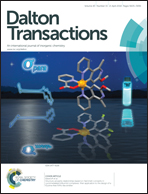Alkyl chlorido hydridotris(3,5-dimethylpyrazolyl)borate imido niobium and tantalum(v) complexes: synthesis, conformational states of alkyl groups in solid and solution, X-ray diffraction and multinuclear magnetic resonance spectroscopy studies†
Abstract
The alkylation of the starting pseudooctahedral dichlorido imido hydridotris(3,5-dimethylpyrazolyl)borate niobium and tantalum(V) compounds [MTp*Cl2(NtBu)] (M = Nb,Ta; Tp* = BH(3,5-Me2C3HN2)3) with MgClR in different conditions led to new alkyl chlorido imido derivatives [MTp*ClR(NtBu)] (M = Nb/Ta, R = CH2CH31a/1b, CH2Ph 2a/2b, CH2tBu 3a/3b, CH2SiMe34a/4b, CH2CMe2Ph 5a/5b), whereas the dimethyl derivatives [MTp*Me2(NtBu)] (M = Nb 6a, Ta 6b) could be isolated as unitary species when the reaction was carried out using 2 equivalents of the magnesium reagent MgClMe. However, the chlorido methyl [MTp*ClMe(NtBu)] (M = Nb 7a, Ta 7b) complexes were obtained by heating at 50 °C the dichlorido and dimethyl imido complexes mixtures in a 1 : 1 ratio. All of the complexes were studied by multinuclear magnetic resonance spectroscopy and the molecular structures of 1b, 2a/b, 3a/b, 4a and 5a/b were determined by X-ray diffraction methods. In the solid state the complexes 1b, 4a and 5a exhibit only a gauche–anti conformation and the complexes 2a/b, 3a/b and 5b exhibit only a gauche–syn conformation of the alkyl substituents, whereas both conformational states, which do not show mutual exchange in the NMR time scale, were observed for 3a/b in a benzene-d6 solution. The 15N chemical shifts of the complexes 1–7 are discussed.


 Please wait while we load your content...
Please wait while we load your content...